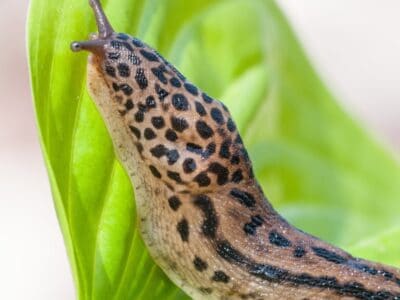Brown Snake
Pseudonaja textilis
Causes the most snake bite deaths in Australia!
Advertisement
Brown Snake Scientific Classification
- Kingdom
- Animalia
- Phylum
- Chordata
- Class
- Reptilia
- Order
- Squamata
- Family
- Elapidae
- Genus
- Pseudonaja
- Scientific Name
- Pseudonaja textilis
Read our Complete Guide to Classification of Animals.
Brown Snake Conservation Status
Brown Snake Facts
- Fun Fact
- Causes the most snake bite deaths in Australia!
- Distinctive Feature
- Shades of brown, black, yellow, orange with mottling or bands
- Diet
- Carnivore
- Average Litter Size
- Five to as many as 38
- Favorite Food
- Reptiles, including conspecifics, reptile eggs, amphibians, rats, mice, birds
- Common Name
- Brown snake, dugite, gwardar, common brown snake
View all of the Brown Snake images!
Brown snakes are rather attractive snakes with slender bodies, beautiful scalation, and unshowy colors.
However, they are among the most venomous snakes on earth, with the eastern brown snake causing 60 percent of snakebite fatalities in Australia. Read on for more information!
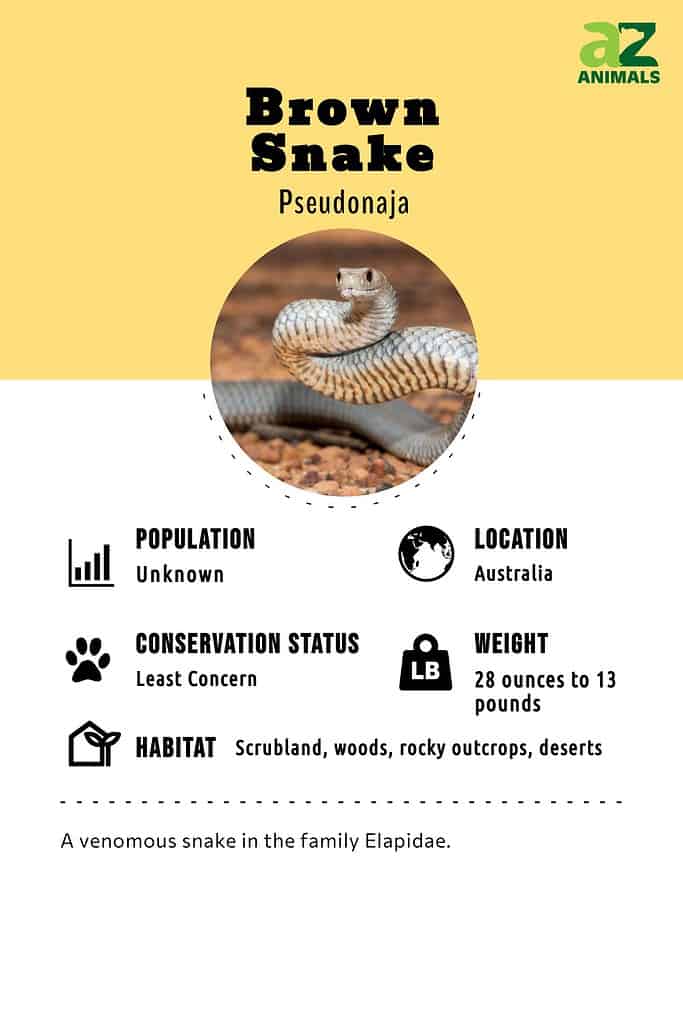
Four Amazing Facts About Brown Snakes
Here are four amazing facts about brown snakes.
- The eastern brown snake has benefitted from habitat disruption in Australia. Turning forests into farmlands flush out the rodents the snake likes to eat.
- They are as dangerous as they are because their venom leads to consumption coagulopathy. This is uncontrolled bleeding, even of the internal organs.
- Despite their venomousness, the fangs of brown snakes are surprisingly small in size.
- Brown snakes have amphibians as part of their diet, but the cane toad is so poisonous that devouring one kills the snake.
Where To Find Them
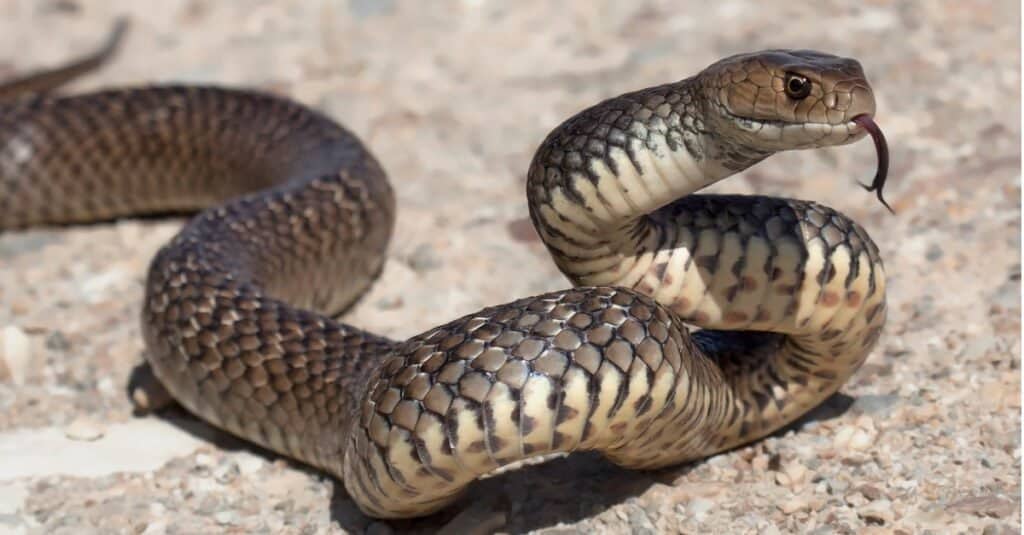
The deadly venomous but beautiful eastern brown snake (Pseudonaja textilis) getting ready to strike.
©iStock.com/KristianBell
These snakes are found in Australia, and at least one species, the eastern brown snake, has been found in New Guinea. Habitat includes scrublands, arid or semi-arid woods, heathland, rocky outcrops, deserts, grasslands, plantations, and near human habitations. They are not endangered and, with the exception of the gwardar, are listed as least concern according to the IUCN Redlist of endangered species. The gwardar’s data is deficient.
Scientific Name
Australian brown snakes belong to the genus Pseudonaja. Pseudo is Latin and Greek for “false,” and naja is derived from naga, the Sanskrit word for “snake.” In this case, naja also means “cobra,” so the snake is a “false cobra.” There are nine recognized species of Pseudonaja, and three subspecies of P. affinis, the dugite. They are:
1. P. a. affinis
2. P. a. exilis
3. P. a. tanneri
The Different Types of Brown Snake
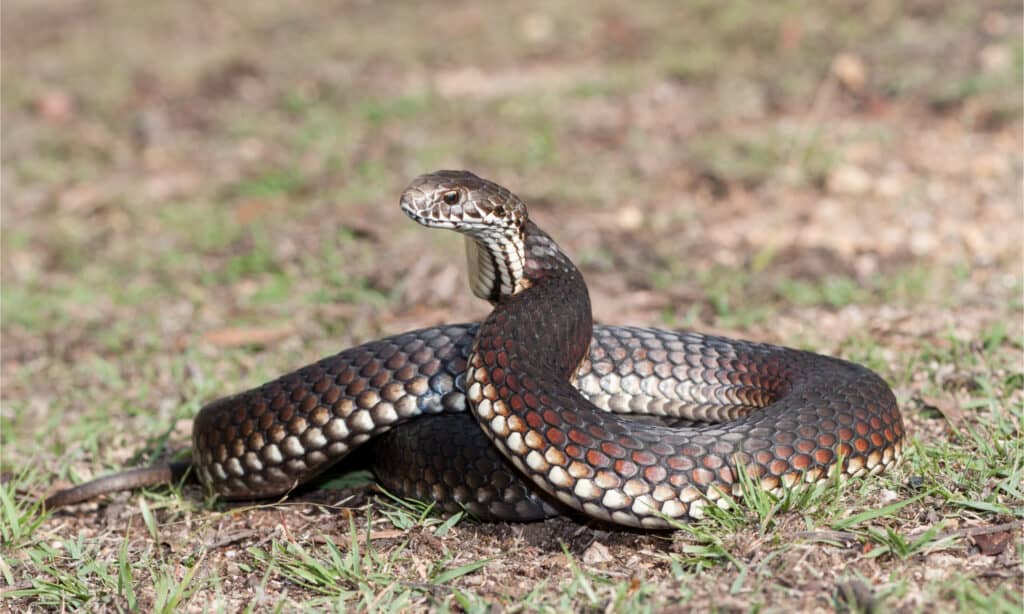
There are nine species of brown snake found in Australia.
©Ken Griffiths/Shutterstock.com
Of the brown snakes, the most venomous is the eastern or common brown snake. It grows to over 6 feet long and has ground colors that range from light to dark brown, black or dark grey, or even orange speckled with black or brown. Juveniles sometimes have black stripes.
The dugite looks very much like the eastern brown snake but is found in fewer and different locations. While the eastern brown snake is found in all of New South Wales and Victoria and most of Queensland, the dugite is located on the Nullabar coast of South Australia, the south coast of Western Australia, and a few islands.
The strap-snouted snake, Pseudonaja aspidorhyncha, has a snout that’s shaped like a chisel. The speckled brown snake, Pseudonaja guttata has an orange to grayish brown top and may have dark bands, blotches, or speckles. It’s the smallest of the Pseudonaja snakes. The scales of the Peninsula brown snake, Pseudonaja inframacula have dark edges that form a pretty net down its back. Ingram’s brown snake, Pseudonaja ingrami, can spot yellow-brown, dark brown, or reddish-brown on its back with a paler head and neck.
Appearance and Description
Identification can be tricky because many of them do look alike. Sometimes only close observation can tell one species from another. Fortunately, trained herpetologists have taken on the task of identification, so laypersons don’t have to.
Counting and noting the characteristics of the snake’s scales is one method of identification. The eastern brown snake, for example, has 17 rows of dorsal scales in the middle of its body and 185 to 235 scales in its belly. There are 45 to 75 scales beneath its tail, and they mostly come in pairs. There are also six scales above its mouth and seven below. Another form of identification is the color of the inside of the mouth. The eastern brown snake has a pink mouth, while the northern and western have black mouths.
Find out the largest brown snake ever recorded.
Diet
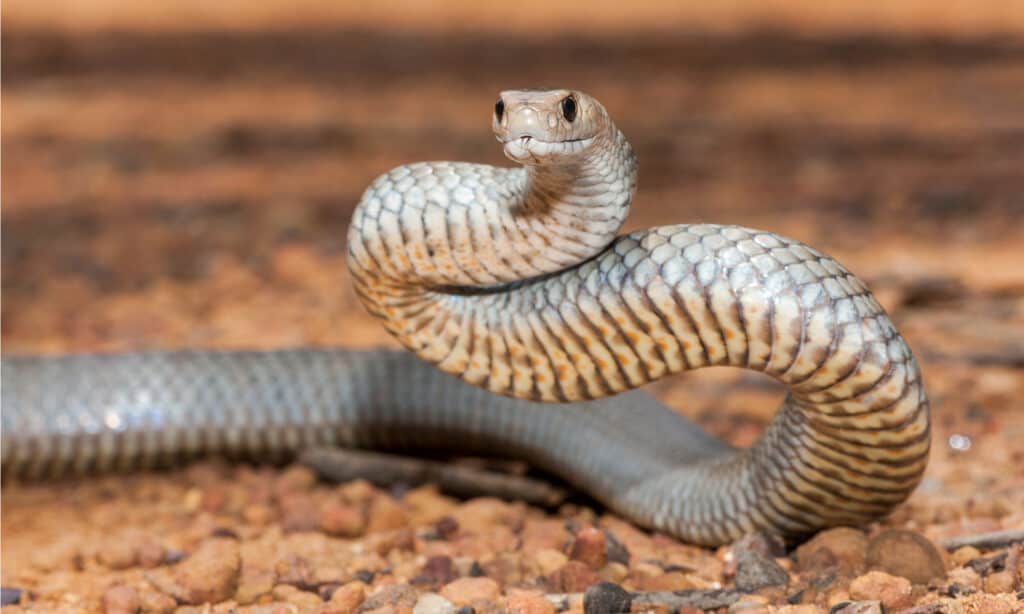
Australian Eastern Brown Snake Pseudonaja textilis eats geckos, mice, and rats.
©Ken Griffiths/Shutterstock.com
Brown snakes, also known as Pseudonaja, are native to Australia and feed primarily on small rodents. They will also consume lizards, frogs, birds, and even other smaller snakes. In some cases, they have been observed eating carrion (dead animals). Brown snakes use venom to subdue their prey before consuming it whole or in pieces.
The diet of the brown snake can vary depending on its individual environment and the availability of food sources. Different populations may specialize in various types of prey, such as rodents or amphibians, due to the localized abundance of those species. Generally speaking, most brown snake populations share a similar dietary composition consisting mainly of small mammals like mice and rats as well as reptiles, including skinks and geckos.
Reproduction and Life Cycle
Mating season for Brown Snakes starts in the middle to late spring. Males are seen engaging in battles with each other for the chance to mate with a female. These fights can last for over thirty minutes, with each snake striving to push down and dominate the other. Females ready themselves to lay eggs between early and late spring (mid-September to end of November), and the eggs are produced from spring to summer.
Mating among Brown Snakes (pseudonaja) in captivity has been observed to occur in early October, with copulation lasting at least 4 hours. Females have the potential to retain sperm for a few weeks after mating, as seen with one female that waited 58 days before laying her eggs. A single clutch may consist of up to 25 eggs, and the female may coil around her eggs for a few hours afterward. The incubation period of the eggs depends on temperature and could range from 36 days to 95 days. Under ideal conditions, females may be able to lay multiple clutches in one season. Brown Snakes are known to share communal nests, including one found in an abandoned rabbit den that contained a large number of eggs.
The young of the Brown Snake species may remain inside their shell for up to eight hours before poking their heads out and displaying the species’ characteristic threat display after just 15 minutes. The size of the hatchlings can vary greatly within and between clutches, ranging from 9.5 inches in length and .28 ounces in weight for one clutch, to 7.5 inches in length and 0.12 ounces in weight for another. All hatchlings have bands on their head and neck, but their body pattern can be plain or banded, with no correlation to sex or incubation temperature.
Elapids have a relatively fast growth rate and are able to reach sexual maturity in a few years. For example, a female Brown snake that hatched in the autumn was able to mate by mid-spring of its third activity season at 31 months old. The lifespan of wild brown snakes is not known, but those that live in captivity have been recorded to survive for up to 7 years. It is likely that these large species of elapids can live for at least ten years.
How Dangerous Are They?
The venom of the brown snake is extraordinarily dangerous and leads to the greatest number of snakebite deaths in Australia, a country full of dangerous snakes. Venom is especially deadly because it keeps blood from forming clots, leading to massive hemorrhaging throughout the body.
The good news is that the snake’s fangs are small and have trouble piercing through good boots or shoe leather, or even heavy clothing such as denim. Sometimes the snake injects so little venom that a bite is harmless; however, if you are bitten by one of these snakes, you need to seek medical attention right away, even if the fangs do not even seem to have broken the skin.
Behavior and Humans
Brown snakes are solitary and avoid each other save during the mating season. Most adults are active during the day, but as the weather gets hot, they may hunt at dusk or night. This is especially true of juvenile snakes.
When the snake isn’t foraging, it rests in an abandoned burrow or a crevice. If the night is warm, they may simply stay above ground. Though they hibernate during the winter, they may come out on warm days to bask. The favorite place to spend the winter, at least in the case of the eastern brown snake, is under the concrete slabs of house foundations.
Mating occurs in the spring, which begins around October in Australia, and males fight over females. The winner gets to mate with the females in his neighborhood. After mating, the female finds a safe space inside a log, tree stump, or burrow and lays her eggs. Female brown snakes may use a communal nest, and some people have seen them curled up over their eggs. However, they’re not sure whether the female is protecting the eggs or whether she’s just tired after laying them.
The incubation period depends on the temperature. Eggs that incubate at lower temperatures can take as much as 95 days to hatch, while those that incubate at higher temperatures can take as little as 36. When they hatch, the baby snakes are independent and fully envenomated. Baby snakes usually take lizards and other smaller reptiles, but they tend to become generalists as they get older. They will even try to eat animals too big for them to swallow. Pseudonajas are probably ready to breed when they’re about 2.5 years old, and they can have a lifespan of up to 15 years.
Brown snakes have no problem living in locations where humans live and work. They’re also fast, jittery, and quick to strike when they feel threatened. The snakes famously rear up, curve their upper bodies into an S-Shape and open their mouths. Interestingly, male snakes are more likely to strike when days are windy and cloudy. For some reason, the snake won’t notice a person until they’re nearly on top of them.
Despite their danger, brown snakes are predators of rats and other vermin that share their habitat and are useful to humans.
Species
- Spotted brown snake – Pseudonaja affinis
- P.a. affinis lives in Western Australia on the coastal mainland
- P.a. exilis lives in Western Australia on the mainland and on Rottnest Island.
- P.a. tanneri lives in Western Australia on the mainland and Boxer island.
- Strap-snouted brown snake – Pseudonaja aspidorhyncha. Lives in Eastern Australia, inland.
- Speckled brown snake – Pseudonaja guttata. Lives in South Australia, Queensland, and Northern Territory.
- Peninsula brown snake – Pseudonaja inframacula. Lives in Southern and Western Australia and the Eyre Peninsula.
- Ingram’s brown snake – Pseudonaja ingrami. Lives in Western Australia, Queensland, and Northern Territory.
- Western (gwardar) brown snake – Pseudonaja mangdeni. Lives in New South Wales, Queensland, Victoria, and Western Australia.
- Ringed brown snake – Pseudonaja modesta. Lives in Northern Territory, Queensland, New South Wales, and South Australia.
- Northern brown snake – Pseudonaja nuchalis. Lives in Queensland, Northern Territory.
- Eastern brown snake – Pseudonaja textiles. Lives in Northern Territory, Queensland, South Australia, Victoria, New South Wales, and Papua New Guinea.
Brown Snake FAQs (Frequently Asked Questions)
Are brown snakes venomous?
Brown snakes are extraordinarily venomous. The eastern brown snake is considered the most venomous terrestrial snake, second only to the inland taipan
How do brown snakes hunt?
These predators hunt through picking up the chemical trails left by their prey, but they also have good eyesight and sometimes raise their heads to look for prey. Sometimes they constrict prey as well as bite it, for their fangs are small in size.
Are brown snakes aggressive?
Brown snakes aren’t so much aggressive as they are easily spooked. They do not chase people and will move away from a what looks like a threatening human if they have the chance to do so.
Where do brown snakes live?
These snakes live in many locations all over Australia. The eastern brown snake has been found in New Guinea as well.
What do brown snakes eat?
These reptile predators eat rodents, reptiles and their eggs, amphibians and birds. Smaller snakes prefer cold-blooded animals as part of their diet, while larger snakes tend to go for birds and mammals.
What is a brown snake?
It is a highly venomous snake that lives in Australia and is a member of the Elapidae family and Pseudonaja genus.
Are brown snakes dangerous?
They are quite dangerous if they bite and envenomate you. Their venom kills more humans than the venom of any other snake in Australia.
How do you identify a brown snake?
It is not necessarily brown but usually is shades of brown with stripes, bands, blotches and spots. It is not large in size and has a slender body. When it feels threatened, it rears up, twists its body into an S-shape and opens its mouth.
What do you do if you see a brown snake?
If you see one, freeze, and let it move away.
What happens when you get bitten by a brown snake?
What happens depends on whether the snake has envenomated you. If you are bitten you should assume that you were envenomated and get help immediately. The venom stops your blood from clotting, and your internal organs can hemorrhage, which can kill you.
How long can you survive after being bitten by a brown snake?
If you do not get help after being bitten by one of these snakes, especially the eastern brown snake, you can survive for about a half an hour.
Are baby brown snakes venomous?
Baby brown snakes are venomous. They can deliver enough venom in a bite to kill a human.
Thank you for reading! Have some feedback for us? Contact the AZ Animals editorial team.











